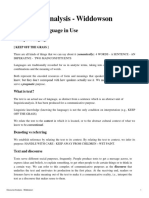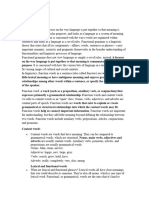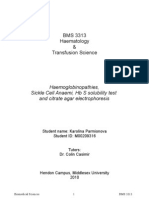0 ratings0% found this document useful (0 votes)
4 viewsChapter 1 - Communication and Language Functions
Chapter 1 - Communication and Language Functions
Uploaded by
SinemtuncThe document discusses the elements and functions of communication and language. It describes the sender, message, receiver, referent, medium, code, and social context as key elements. It then explains the expressive, directive, informative, phatic, poetic, and metalinguistic functions of language.
Copyright:
© All Rights Reserved
Available Formats
Download as DOCX, PDF, TXT or read online from Scribd
Chapter 1 - Communication and Language Functions
Chapter 1 - Communication and Language Functions
Uploaded by
Sinemtunc0 ratings0% found this document useful (0 votes)
4 views4 pagesThe document discusses the elements and functions of communication and language. It describes the sender, message, receiver, referent, medium, code, and social context as key elements. It then explains the expressive, directive, informative, phatic, poetic, and metalinguistic functions of language.
Copyright
© © All Rights Reserved
Available Formats
DOCX, PDF, TXT or read online from Scribd
Share this document
Did you find this document useful?
Is this content inappropriate?
The document discusses the elements and functions of communication and language. It describes the sender, message, receiver, referent, medium, code, and social context as key elements. It then explains the expressive, directive, informative, phatic, poetic, and metalinguistic functions of language.
Copyright:
© All Rights Reserved
Available Formats
Download as DOCX, PDF, TXT or read online from Scribd
Download as docx, pdf, or txt
0 ratings0% found this document useful (0 votes)
4 views4 pagesChapter 1 - Communication and Language Functions
Chapter 1 - Communication and Language Functions
Uploaded by
SinemtuncThe document discusses the elements and functions of communication and language. It describes the sender, message, receiver, referent, medium, code, and social context as key elements. It then explains the expressive, directive, informative, phatic, poetic, and metalinguistic functions of language.
Copyright:
© All Rights Reserved
Available Formats
Download as DOCX, PDF, TXT or read online from Scribd
Download as docx, pdf, or txt
You are on page 1of 4
Chapter 1
Communication and Language Functions
------------------------------------------------------------------------------------------------------------------------
1.1. The Elements of a Model of Communication:
You have to know how to make the appropriate choices in any communication situation so
that the text produced correlates with the situation in which it occurs.
There is a number of factors that takes place in communication:
1. There is a sender – who wants to communicate
2. Message – the message the sender wants to send.
3. Reciever – the reciever is the one who the message is for.
4. Referent – what the sender wants to communicate about.
5. The sender has to choose between the spoken (say the message out loud) or the written
(written down) – this is also called Medium.
6. Before all this takes place, he will probably have given some thought to the type of situation
the text he is about to produce will have to fit into, the so-called social context.
7. There is a code that the sender has to think of to encode his text e.g. Morse, Danish or
maybe English.
“Communication model”:
1.1.1 The code:
It is the way of telling something e.g. morse, English or danish.
By choosing the language as a code the sender knows the signs and rules to encode his
message, and the reciever knows how to decode it.
It is not simple; the code comprises a lot of things;
Morphology – deals with the internal structure of words.
Syntax – which deals with the rules about words combination in sentences.
Semantics – which is the study of meaning
Pragmatics – which is the study of language usage
Text constitution – which is the study of text production.
1.1.2 The Medium
In medium we distinguish between; speech and writing.
A lecturer can prepare what to say in writing, but not realise that hist text was easier to
understand if it was read instead if he spoke the words.
All in all, sometimes we find it easier when we read it instead of hearing it. And the same
vice versa. Sometimes what is written down can be difficult to understand then hearing it.
The differences between speech and writing:
The spoken medium: is used in the following channels:
The radio, the telephone, TV, conversation etc.
The written medium: is used in the following channels:
Newspapers, magazines, books, TV, computers, letters
1.1.3 The sender and Reciever
The sender and reciever may not agree about their relative status, each speaking to the other
as superior-to-inferior or inferior-to-superior for reasons of politeness.
The relationship between sender and reciever is clearly revealed in the use of particular
terms of address and personal pronouns.
Gender and age are also an important factor, for how you chose your code.
Where does the communication take place?
Between individuals, government, an institution, a newspaper, a company etc.
The sender and reciever can also be fictional such as in novels and play.
1.1.4 The text
A text may be of any length; one word like STOP! or several volumes like, say, a novel.
1.1.5 The Referent
What is the subject? What is it about?
It is referring to something – and this is called the referent.
1.1.6 The Social Context/Situation
The social context is the situation in which the text occurs, the framework around the text
example a recipe.
The sender´s choices with regard to words and structures will depend on the situation.
Alle his choices will produce and overall conventionalized spoken or writing text that fits a
particular situation.
Example:
Recipe – a recipe has some characteristic features, a special layout and form. They are
writing in a special way.
1.2 Functions of Language
Any text – spoken or written – has a number of language functions.
Each of these six factors determines a different function of language:
Sender: The expressive language function
Reciever: The directive language function
Context: The informative language function
Channel: The phatic language function
Message: The poetic language function
Code: The metalinguistic language function
1.2.1 The expressive Language functions
If the focus of attention in a text is the sender, the meaning is expressive (her/his attitudes).
You use connotative instead of denotative
Subjective rather than objective
More personal.
References to feelings, state of mind, health etc.
Example: “I am tired”.
This is expressive if the context allows it. The sender express something.
1.2.2 The Directive Language Function
Is used where the focus of attention is the reciever.
Example: “Peter! Come here a minute!”.
Have to be directive – you can use persuasion.
1.2.3 The Informative Language Function
A text that has its focus on the subject is informative it focuses on the contexts of a text.
The informative language function is characteristic of non-fictional texts.
1.2.4 The Phatic Language Function
The Phatic language function focuses on the channel between sender and reciever.
Phatic language may be greetings or talk of the weather etc.
1.2.5 The Poetic language functions
Focuses on the message
It can be:
1. Alliteration – repetition of words of the same letter or sound e.g. The majestic, the
magnificent Mississippi.
1.2.6 The Metalinguistic Language Function
This use of language focuses on the code.
You can use dictionaries and grammars.
Many uses this to check their speech or searching for an appropriate term.
You might also like
- TOPIC 1 Oposiciones Inglés PrimariaDocument9 pagesTOPIC 1 Oposiciones Inglés PrimariaMary Vazram100% (2)
- Messaging: beyond a lexical approach in ELTFrom EverandMessaging: beyond a lexical approach in ELTRating: 5 out of 5 stars5/5 (1)
- Discourse Analysis - WiddowsonDocument20 pagesDiscourse Analysis - WiddowsonCasandra RobledoNo ratings yet
- Dlp-Eng-G10-Q1-Melc-7-Week 7Document10 pagesDlp-Eng-G10-Q1-Melc-7-Week 7JanethRonard BaculioNo ratings yet
- Test Help StatDocument18 pagesTest Help Statthenderson22603No ratings yet
- PDF Version Mode Field Function Audience and Language LevelsDocument7 pagesPDF Version Mode Field Function Audience and Language Levelsapi-360004576No ratings yet
- Topic 1 Language As CommunicationDocument8 pagesTopic 1 Language As CommunicationDavid Racero PonceNo ratings yet
- Experiment 9 Measurement of Hydraulic Conductivity of Granular SoilsDocument12 pagesExperiment 9 Measurement of Hydraulic Conductivity of Granular SoilsAllyssa SuyatNo ratings yet
- MaterialDocument22 pagesMaterialnagarajNo ratings yet
- Book - History of The OfficeDocument18 pagesBook - History of The OfficeShe EogNo ratings yet
- EOI Unit 1Document18 pagesEOI Unit 1jodemodeNo ratings yet
- Report ExplanationDocument3 pagesReport ExplanationShaine CababatNo ratings yet
- Topic 5. La Comunicación Oral. Elementos Y Normas Que Rigen ElDocument7 pagesTopic 5. La Comunicación Oral. Elementos Y Normas Que Rigen ElYaiza GabardaNo ratings yet
- The Linguistic Sign Spoken and Written Language 2.2.1 Differences 2.2.2 The Relationship Between Speech and WritingDocument7 pagesThe Linguistic Sign Spoken and Written Language 2.2.1 Differences 2.2.2 The Relationship Between Speech and WritingJorge SGNo ratings yet
- A Sample of LanguageDocument5 pagesA Sample of LanguageRecep DidemNo ratings yet
- Unit 1. Language As Communication. Oral and Written Language. Factors That Define A Communicative Situation. Functionality. The Communicative Approach To FLTDocument7 pagesUnit 1. Language As Communication. Oral and Written Language. Factors That Define A Communicative Situation. Functionality. The Communicative Approach To FLTfiicusNo ratings yet
- Topic 1Document8 pagesTopic 1ldommen011No ratings yet
- Lecture 1Document24 pagesLecture 1batutincapNo ratings yet
- Unit 6Document11 pagesUnit 6Arian MarsinyachNo ratings yet
- M1 DLE Discourse Analysis S2Document29 pagesM1 DLE Discourse Analysis S2banuNo ratings yet
- 12 Language As Text Course Participants NotesDocument12 pages12 Language As Text Course Participants NotesAngelNo ratings yet
- Unit 5Document12 pagesUnit 52k22.csds.2212634No ratings yet
- Discourse Analysis: Why Formal Links Are Not Enough?Document7 pagesDiscourse Analysis: Why Formal Links Are Not Enough?sadiqmazariNo ratings yet
- Topic 5Document9 pagesTopic 5Arian MarsinyachNo ratings yet
- Topic 1 - Language As Communication Oral and Written Language. Factors That Define A Communicative Situation Sender, Receiver, Functionality and Context.Document11 pagesTopic 1 - Language As Communication Oral and Written Language. Factors That Define A Communicative Situation Sender, Receiver, Functionality and Context.maria100% (1)
- A Learner's Guide To WritingDocument23 pagesA Learner's Guide To WritingmindnbooksNo ratings yet
- Purposive Communication ReviewerDocument4 pagesPurposive Communication Reviewerwellalltoo13No ratings yet
- Theory of Translation N InterpretingDocument10 pagesTheory of Translation N InterpretingNguyễn Đan NhiNo ratings yet
- Capitolo 2 Language Functions and TranslationDocument20 pagesCapitolo 2 Language Functions and TranslationFrensiNo ratings yet
- Spoken and Written DiscourseDocument8 pagesSpoken and Written DiscourseYulianipramita100% (1)
- Uses of LanguagesDocument3 pagesUses of Languagesसाक्षी सिंहNo ratings yet
- Topic6 Assessing Language Skills and ContentDocument29 pagesTopic6 Assessing Language Skills and ContentYahya YusofNo ratings yet
- Topic 1 Language As CommunicationDocument10 pagesTopic 1 Language As CommunicationDavid Racero Ponce100% (1)
- TC UNIT 5 NotesDocument12 pagesTC UNIT 5 Notes26dsmuknuNo ratings yet
- Functional GrammarDocument5 pagesFunctional Grammarebtsamali999No ratings yet
- Tema 6Document8 pagesTema 6LauraNo ratings yet
- Ing Unit 1Document5 pagesIng Unit 1Ely A G BaldNo ratings yet
- Modul PPG 2 PKB 3105topic 1Document14 pagesModul PPG 2 PKB 3105topic 1Isteri En RidzuanNo ratings yet
- Comment On The Basic Approaches To Translation and InterpretationDocument4 pagesComment On The Basic Approaches To Translation and InterpretationИлона Киреева50% (2)
- Pragmatics - September 2021Document28 pagesPragmatics - September 2021Vân Anh Lê ThịNo ratings yet
- English A Prelim ModuleDocument9 pagesEnglish A Prelim ModuleJian P MendozaNo ratings yet
- Topic 1 Understanding LanguageDocument12 pagesTopic 1 Understanding Languagelim07-148No ratings yet
- Eng449 Notes ADocument11 pagesEng449 Notes Amusic relaxNo ratings yet
- Unit 1. English Language For BusinessDocument35 pagesUnit 1. English Language For Businessvansha.kanojiaNo ratings yet
- English For Academic Purposes ProgramDocument43 pagesEnglish For Academic Purposes Programcaila.b.ereseNo ratings yet
- Unit 4.2. Testing ListeningDocument16 pagesUnit 4.2. Testing ListeningUziel BeltranNo ratings yet
- FINAL-HANDOUTS_Purposive-CommunicationDocument30 pagesFINAL-HANDOUTS_Purposive-CommunicationMarian Medilo EsyangNo ratings yet
- Newmark - A Textbook of TranslationDocument20 pagesNewmark - A Textbook of TranslationCarli Lupi100% (1)
- Topic 39Document4 pagesTopic 39Haydée PalomoNo ratings yet
- Module 1 English A Spoken and Conversational EnglishDocument6 pagesModule 1 English A Spoken and Conversational EnglishNel Sydric CanjaNo ratings yet
- LANGUAGE As COMMUNCIATION - Oral and Written Language. Factors Defining A Communicative Situation - Listener - Code - Functionality and Context.Document8 pagesLANGUAGE As COMMUNCIATION - Oral and Written Language. Factors Defining A Communicative Situation - Listener - Code - Functionality and Context.tere1_San9No ratings yet
- SemanticDocument29 pagesSemanticRiska Alfin PramitaNo ratings yet
- Apuntes GramáticaDocument50 pagesApuntes GramáticaSara M LNo ratings yet
- EN2 - Language and Text LiteracyDocument60 pagesEN2 - Language and Text Literacyarwa hassanNo ratings yet
- A Course in The Theory of TranslatingDocument47 pagesA Course in The Theory of TranslatingPhamThienAnNo ratings yet
- Business CommunicationDocument4 pagesBusiness CommunicationChandan Kumar BanerjeeNo ratings yet
- Angelina Winata - InterpretingDocument4 pagesAngelina Winata - InterpretingAngelina WinataNo ratings yet
- Examenu de StatDocument4 pagesExamenu de StatValentina CherchejaNo ratings yet
- Differences Between Speech and WritingDocument7 pagesDifferences Between Speech and WritingVũ Mai AnhNo ratings yet
- Opos 3Document5 pagesOpos 3ESTHER AVELLANo ratings yet
- 1.speech Vs WritingDocument16 pages1.speech Vs Writinglilamy84100% (1)
- English Grammar Made Easy: How to Understand English Grammar as a BeginnerFrom EverandEnglish Grammar Made Easy: How to Understand English Grammar as a BeginnerRating: 5 out of 5 stars5/5 (1)
- Style Matters: Elevating Your Writing with Engaging TechniquesFrom EverandStyle Matters: Elevating Your Writing with Engaging TechniquesNo ratings yet
- Group Members: Akshat Jain Jitendra Jain Nitish Nijhawan Shubham Agarwal Sweta RamdasDocument8 pagesGroup Members: Akshat Jain Jitendra Jain Nitish Nijhawan Shubham Agarwal Sweta Ramdasmaster1No ratings yet
- GL-15 Fire Safety Engineered Alternative Building SolutionsDocument12 pagesGL-15 Fire Safety Engineered Alternative Building SolutionsJoe.StrongNo ratings yet
- Sociology AssignmentDocument2 pagesSociology AssignmentKiro Da rareNo ratings yet
- Clip 199Document2 pagesClip 199zuhairahmed07No ratings yet
- Science GR 4 1st-Periodical-TestDocument7 pagesScience GR 4 1st-Periodical-TestkristalNo ratings yet
- 2-D Line Plot - MATLAB Plot - MathWorks IndiaDocument6 pages2-D Line Plot - MATLAB Plot - MathWorks Indiavikram_908116002No ratings yet
- Daftar BukuDocument12 pagesDaftar BukuRufus PearleyNo ratings yet
- Global Education Magazine: International Youth DayDocument95 pagesGlobal Education Magazine: International Youth DayGlobal Education MagazineNo ratings yet
- Nail Care LPDocument5 pagesNail Care LPMerlinda AridaNo ratings yet
- The Ethnography of SpeakingDocument10 pagesThe Ethnography of SpeakingFelipe Amado IngestaNo ratings yet
- Harish Phulara: Executive ProfileDocument2 pagesHarish Phulara: Executive ProfileHarish PhularaNo ratings yet
- IPMZ Higher Dip Assignment Booklet April 2013Document15 pagesIPMZ Higher Dip Assignment Booklet April 2013Ngoni MukukuNo ratings yet
- Sickle Cell LabDocument7 pagesSickle Cell LabKarolina ParNo ratings yet
- PacktPublishing - ServiceNowCookbook - This Is The Code Repository For The Book, ServiceNow Cookbook, Published by PacktDocument4 pagesPacktPublishing - ServiceNowCookbook - This Is The Code Repository For The Book, ServiceNow Cookbook, Published by PacktGiriprasad GunalanNo ratings yet
- Command Reference Guide - Legato Networker, Release 7.0: Download InstructionsDocument2 pagesCommand Reference Guide - Legato Networker, Release 7.0: Download InstructionsajyshowNo ratings yet
- Weather VocabularyDocument2 pagesWeather VocabularyasukittaNo ratings yet
- Design and Pedagogy of The Introductory Programming Course: Abhiram Ranade IIT BombayDocument57 pagesDesign and Pedagogy of The Introductory Programming Course: Abhiram Ranade IIT BombayProfessor, CSE Veltech, ChennaiNo ratings yet
- Country Profile TemplateDocument1 pageCountry Profile Templatedarrenbodhiputra888No ratings yet
- SP3D Electrical User's GuideDocument228 pagesSP3D Electrical User's GuideJi Balaji33% (3)
- Template: INTOSAI Development Initiative, C/o Riksrevisjonen, Postboks 8130 Dep, N-0032 Oslo, NorwayDocument6 pagesTemplate: INTOSAI Development Initiative, C/o Riksrevisjonen, Postboks 8130 Dep, N-0032 Oslo, NorwaySolution ValueNo ratings yet
- Manual TestingDocument7 pagesManual TestingvenugopalNo ratings yet
- IMM Hypress Hose FittingsDocument80 pagesIMM Hypress Hose FittingsJohn AllenNo ratings yet
- Application Form Offshore Tech.Document4 pagesApplication Form Offshore Tech.nmraman6224No ratings yet
- Scale Skills LevelsDocument1 pageScale Skills LevelsAalam KhanNo ratings yet
- An Improved Gravimetric Method To PHCDocument12 pagesAn Improved Gravimetric Method To PHCalahzabNo ratings yet
- Module 7 Behaviorism Pavlov Thorndike Watson and SkinnerDocument7 pagesModule 7 Behaviorism Pavlov Thorndike Watson and SkinnershielaNo ratings yet

























































































